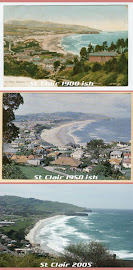Sinkholes in the Esplanade at St Clair could get bigger over the next week, but the Dunedin City Council is happy the damage is contained to that immediate area.
It says preliminary tests indicate there is no immediate concern about the safety of the rest of the sea wall.
At least one business owner in the area yesterday expressed concern about a lack of information being provided by the council on the status of the wall.
Starfish Cafe co-owner Cushla Dodds said because the holes appeared to be growing and the council had told her nothing, she had checked her insurance policy, just in case. She said she knew other businesses had too.
Business was being affected because people thought they could no longer walk around the Esplanade or bring their dogs there, she said.
People also wanted to know the long-term plans for the seafront. She had not contacted the council, but felt she should not have to.
Next door, florist Carley Jones told Radio New Zealand that each day the drama went on, the more scary it became.
Council roading network engineer Peter Standring said the situation yesterday was that the council expected sinkholes in front of the South Coast Board Riders' Association at the north end of the sea wall would continue to grow in a northerly direction over the next week, as contractors worked in two-hour bursts around tides, to plug gaps underneath the sea wall at that end.
The amount of walkway fill being sucked out through those gaps had already been reduced by remedial action taken since the first hole appeared on Sunday, but material could still disappear until sheet piling along the base of the northern end of the wall was completed, he said.
The sheet piles were being sunk 3m deeper than the foot of the sea wall along the 50m section of wall.
The work was being done in sections and had started around the St Clair Surf Life Saving Club's ramp, where the biggest gaps were. It was expected to take at least another week, because access was limited by the tides.
He said it was anticipated the pits in the walkway would eventually extend along more or less that whole section of the walkway, to the northern end.
However, engineers had indicated the damage would be contained to that area.
A preliminary check by engineers and a ground-penetrating radar had not revealed any voids under the remainder of the wall or walkway along to the salt water pool.
Mr Standring said the priority was to plug the gaps where the beach level had gone below the bottom of the wall.
A more extensive assessment of the rest of the wall would then be made and a long-term response considered once that work was completed.
A portion of the Esplanade walkway along its length and about 3m back from the wall would remain cordoned off until at least then. The cordon still allowed room for foot traffic.
Council operations manager Tony Avery said the council had not approached businesses or residents in the area because there was no concern about the remainder of the wall, although it certainly would if there were any concerns.
He said anyone wanting information could contact the council on 477-4000.





